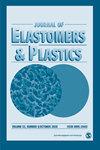Admicellar Polymerization of Polystyrene on Natural Rubber Particles
IF 1.6
4区 材料科学
Q4 MATERIALS SCIENCE, MULTIDISCIPLINARY
引用次数: 4
Abstract
Admicellar polymerization is a reaction for coating a thin-film of polymer on a surface. The process consists of the polymerization of the adsolubilized monomer in the hydrophobic regions of the surfactant bilayers that adsorbed on the substrate surface. In this research, the admicellar polymerization of polystyrene was carried out using micron to submicron size natural rubber particles as substrates. Cetyl trimethyl ammonium bromide (CTAB) was used to form the surfactant template. The adsorption isotherm of CTAB was determined in the absence and presence of salt. Styrene adsolubilization was found to increase with initial styrene concentration and in the presence of salt. The synthesized polystyrene in the molecular bilayer of micelles surrounding the natural rubber particles was characterized by optical microscope, Fourier transform infrared spectroscopy (FTIR), and thermogravimetric analysis (TGA). The observed morphology of the rubber particles after reaction was clearly two phases, a core-shell structure having the natural rubber core covered by the polystyrene shell. These core-shell particles were spheres and aggregated strongly in the emulsion. Effect of initiator type was investigated. The synthesized products showed core-shell morphology, which was still obtained after heating but after cooling phase inversion occurred and showed polystyrene-rich core and natural rubber-rich shell. Thin lamellar of both components was found in both polystyrene-rich core and natural rubber-rich shell making unique morphology and extended single transition of thermal decomposition. FTIR results show characteristic peaks of natural rubber and polystyrene and the absorbance of styrene increases with increasing styrene content. The TGA result showed that the decomposition temperatures of the products were altered by the amount of polystyrene.聚苯乙烯在天然橡胶颗粒上的胶束聚合
胶束聚合是在表面涂覆聚合物薄膜的一种反应。该过程包括在吸附在衬底表面的表面活性剂双分子层的疏水区域中聚合被溶解的单体。本研究以微米至亚微米大小的天然橡胶颗粒为底物,对聚苯乙烯进行了胶束聚合。用十六烷基三甲基溴化铵(CTAB)制备表面活性剂模板。测定了CTAB在无盐和有盐条件下的吸附等温线。发现苯乙烯的增溶作用随着苯乙烯初始浓度和盐的存在而增加。采用光学显微镜、傅立叶红外光谱(FTIR)和热重分析(TGA)对天然橡胶颗粒周围胶束分子双层中的合成聚苯乙烯进行了表征。观察到反应后的橡胶颗粒形貌明显为两相结构,即天然橡胶芯被聚苯乙烯壳覆盖的核-壳结构。这些核壳颗粒呈球形,在乳液中强烈聚集。探讨了引发剂类型对其影响。合成产物呈现出加热后仍能得到的核-壳形态,但冷却后发生了相转变,显示出富含聚苯乙烯的核和富含天然橡胶的壳。在富含聚苯乙烯的芯层和富含天然橡胶的壳层中都发现了两种组分的薄层状结构,形成了独特的形态和延长的热分解单次转变。FTIR结果显示天然橡胶和聚苯乙烯的特征峰,并且苯乙烯的吸光度随苯乙烯含量的增加而增加。热重分析结果表明,产物的分解温度随聚苯乙烯用量的变化而变化。
本文章由计算机程序翻译,如有差异,请以英文原文为准。
求助全文
约1分钟内获得全文
求助全文
来源期刊

Journal of Elastomers and Plastics
工程技术-材料科学:综合
CiteScore
3.30
自引率
5.90%
发文量
41
审稿时长
6 months
期刊介绍:
The Journal of Elastomers and Plastics is a high quality peer-reviewed journal which publishes original research on the development and marketing of elastomers and plastics and the area in between where the characteristics of both extremes are apparent. The journal covers: advances in chemistry, processing, properties and applications; new information on thermoplastic elastomers, reinforced elastomers, natural rubbers, blends and alloys, and fillers and additives.
 求助内容:
求助内容: 应助结果提醒方式:
应助结果提醒方式:


